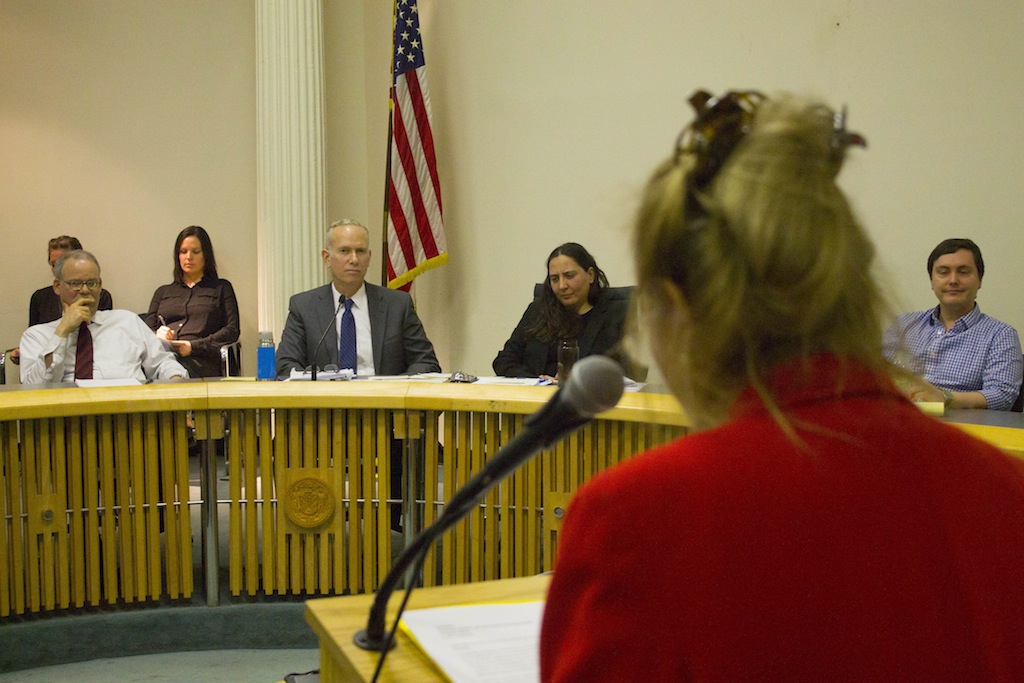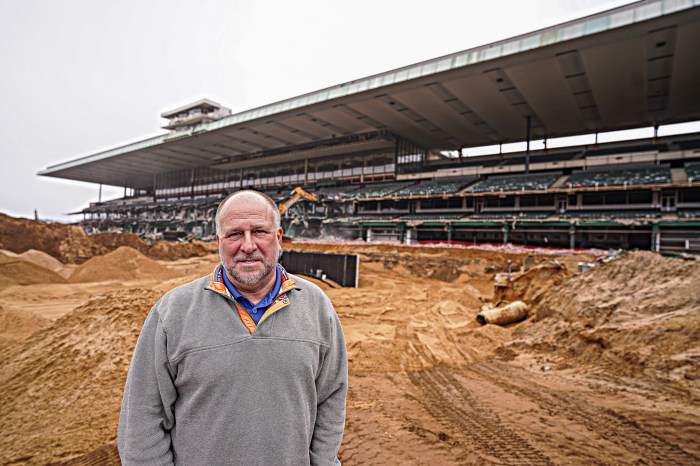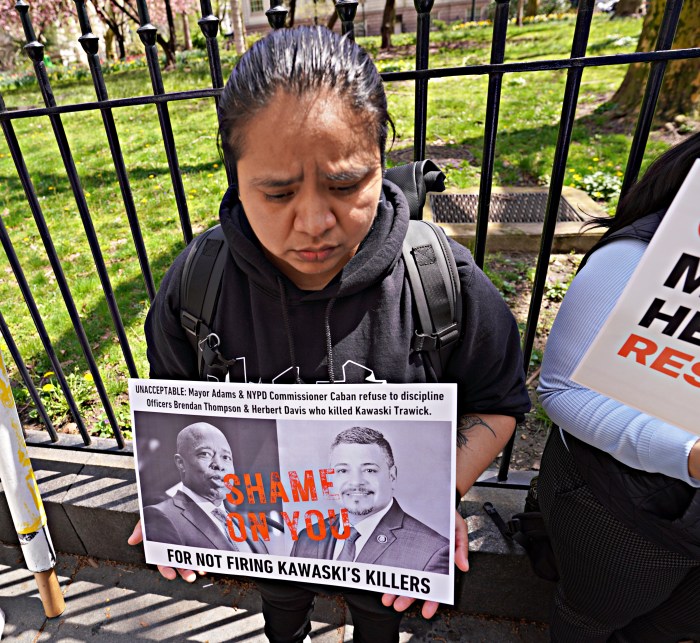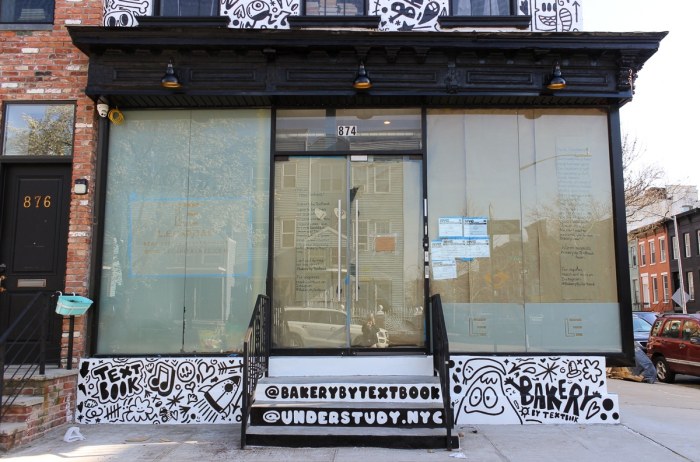
BY ZACH WILLIAMS | Community board members, politicians and preservationists came together at City Hall on Wed., March 25, to slam a zoning proposal that they warned would wipe away years of determined work by the Village and Chelsea communities to keep development in check and maintain the historic fabric of their neighborhoods.
The occasion was a scoping meeting by the Department of City Planning to consider what matters should be covered in an Environment Impact Statement, or E.I.S. — a preliminary step to enact Mayor Bill de Blasio’s citywide rezoning proposal, known as “Housing New York: Zoning for Quality and Affordability.”
Concerned that such changes would drastically overhaul regulations on the height, size and shape of new residential developments, more than 100 people attended the meeting to comment on the plan.
Critics — including members of Community Boards 2 and 4 — told Planning officials that the approval process has been moving way too fast, neglects neighborhood nuance, and could jeopardize their efforts to balance development with neighborhood character and needs.
Right before the hearing, a rally was held on the City Hall steps, at which critics of the plan asserted that the proposed changes, which are intended to boost affordable housing in the city, would instead benefit luxury, market-rate development.
Current restrictions of 70 feet in West Chelsea and Greenwich Village were the results of negotiations made years ago during a prior rezoning effort, with the expectation that they would remain firmly in place, according to Councilmember Corey Johnson.
“Those rezonings took place because people said, ‘O.K., give us the cap here and we will trade you somewhere else and give you an upzoning.’ This would wipe all of this away in many instances,” he said at the rally, which drew about 50 supporters and politicians from throughout the city.
Andrew Berman, executive director of the Greenwich Village Society for Historic Preservation, also spoke at the rally, and said the zoning changes would wipe away years of hard work.
“Just to be clear, this plan that has been proposed by the city would change rules that communities fought for years and years and years to get to help protect the scale and character of their neighborhoods,” he said. “And, in a lot of cases, these proposed changes by the city are really for nothing but market-rate luxury condo development,” he added.
Planning wants to expand affordable housing by “modernizing” the zoning regulations in contextually zoned districts, which developers say stymie construction and restrict their ability to maximize building sizes within the current zoning.
But critics worry that the changes could lead to more high-rises while not effectively addressing the need for more affordable housing. Approval of the zoning changes could also impose a “one-size-fits-all” approach at the expense of neighborhood character, critics stressed at both the rally and the hearing.
A draft scope of the study was made public a month beforehand, but community board members said they really only had a single week to prepare their own analysis of the 166-page document, which was released in February.
Contextual zoning regulates the height, bulk, setback from street, and frontage width in new buildings — with the purpose of maintaining the architectural character of neighborhoods.
At the meeting, Elizabeth Mackintosh, co-chairperson of the C.B. 4 Land Use Committee, expressed the frustration that community board members have felt over the rushed initiative and the lack of opportunity for dialogue and questions about it.
“Commenting on the draft scope of work is very challenging since we don’t have the actual zoning text to view,” she said. “So far, it appears that a number of proposed goals are very sound, but of course the devil is in the details.”
Mackintosh also offered suggestions to the Planning officials on the scope of the environmental review for the zoning. The agency needs to study on the environmental impact the zoning changes would have on contextually zoned districts — like those in the Village and Chelsea — as well as how increased building heights could affect views, shadows, light, air quality and affordable housing. More research is also needed on just how many market-rate and affordable units exist in these districts now, and would be anticipated in the future.
Mackintosh’s committee co-chairperson, Lee Compton, added that study is also needed into a proposed increase in commercial ground-floor heights — especially regarding how they might affect local businesses and neighborhood character. Loosening restrictions on backyard spaces to create more room for residential units necessitates scrutiny, as well, he said, because that could, in turn, increase people’s use of other open spaces in the neighborhood.
Borough President Gale Brewer and 26 other Manhattan elected officials sent a joint letter to Carl Weisbrod, chairperson of the City Planning Commission, expressing their concerns about the current trajectory of the proposed zoning changes.
According to Christine Berthet, C.B. 4 chairperson, community board representatives told Brewer at a Borough Board meeting on March 19 that the process was moving too fast and threatening to undermine their previous, carefully considered zoning work.
“By increasing height limits across the board, this administration is undermining these agreements made between previous administrations and neighborhood residents,” the elected officials’ March 25 letter reads.
“While it may be true that the constraints of the contextual building envelope are stifling the production of housing, we are not convinced that the proposed adjustments are the perfect solution.”
Representing C.B. 2 were Tobi Bergman and Terri Cude, the board’s chairperson and first vice chairperson, respectively.
“Community Board 2 wholeheartedly supports the stated goals of this plan,” Bergman said. “But the way it is proposed now it will harm the character of many neighborhoods throughout the city, including ours. This plan is deep and wide with major citywide impacts. So we think it is smarter to add 60 days to the beginning of the process and get it right. Otherwise, it’s likely that many who support the goals will end up fighting against the plan.”
The current zoning rules went into effect in 1987. Changes are needed in order to meet the demands of Mayor Bill de Blasio’s affordable housing push, according to representatives of the Citizens Housing and Planning Council, who presented their own research to the C.B. 4 Land Use Committee on March 16. The nonprofit group represents the perspectives of a board including nearly 100 architects, developers and lawyers.
Of particular concern to C.H.P.C. is how the limitations on building dimensions (called “the envelope”) reduce the amount of residential units in a new development. A 2014 C.H.P.C. study examined 17 development projects in the city — none of which were in Manhattan south of 96th St. Only the developer of one project out of that sampling was able to maximize floor space under current restrictions, according to the report.
In the 28 years since the zoning was put in place, average floor-to-floor heights have increased from about 8 feet 8 inches to 9 feet or more, the study noted. Current building practices also require more infrastructure between floors — such as fire sprinklers and soundproofing materials. As a result, this limits the amount of floors permitted by what C.H.P.C. called the current “rigid” building height limits.
Mark E. Ginsberg, C.H.P.C. president, said, factoring in the need to keep down design and construction costs, the current conditions are simply too restricting.
“We’ve created this straitjacket, where if you look at a lot of the buildings, there’s very little variation besides the color of the brick, because developers are trying to take all the floor area and fit it into the building,” he told the C.B. 4 Land Use Committee at their regularly scheduled monthly meeting.
Limiting a building’s height by floors rather than feet is one way to inject more residential units into a development, according to the group’s report.
“Many C.H.P.C. board members,” the report says, “believe that New York City should begin to move away from such prescribed requirements for our built environment and make a shift toward performance zoning — an alternative system to traditional land use planning that uses performance-based, or goal-oriented criteria.”
Removing obstacles to housing production and reducing construction costs are key strategies of de Blasio’s affordable housing plan, which aims to preserve or create 200,000 units of affordable housing by 2024.
City Planning is in the midst of a yearlong process, preparing recommendations to both the City Planning Commission and City Council on zoning changes. In addition to hearing public comment, the March 25 meeting was meant to refine content for the E.I.S., a draft of which is scheduled to be completed this spring.
















